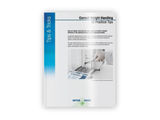To use all functions of this page, please activate cookies in your browser.
my.bionity.com
With an accout for my.bionity.com you can always see everything at a glance – and you can configure your own website and individual newsletter.
- My watch list
- My saved searches
- My saved topics
- My newsletter
Frozen plasticity
Frozen plasticity is a hypothesis in evolutionary biology based on punctuated equilibria and augmenting it with a mechanism for species stability based on evolutionarily stable strategies on the gene and allele level. Additional recommended knowledge
MechanismMature speciesIn a mature species, many genes have several alleles and the alleles of different genes interact in a complex web of epistatic interactions. Most traits are codetermined by a large number of genes, many of which contribute in various degrees to different traits. In sexually-reproducing species, only 50% of these will be passed on to a descendant, with the other 50% coming from the other parent. As such, the selfish gene cannot be simply selfish; it is participating in a large number of games against other genes, one game per generation, and many of the solutions will be mixed evolutionarily stable strategies, corresponding to particular frequencies of different alleles. As with the Hawk-Dove game, if we apply artificial selective pressure, the frequencies will shift; however, as soon as the pressure is removed, the game will return to its natural equilibrium. Similarly, if a new mutant allele arises (and is not immediately eliminated), the frequencies of the various existing alleles may shift, but the nature of the equilibrium is unlikely to be significantly changed. Speciation and evolution through natural selectionPeripatric speciation (or another event which leaves a small number of individuals genetically isolated) reduces genetic variability through the founder effect and further through subsequent genetic drift. This makes the group genetically plastic, but too small for natural selection to work. When the number of individuals grows, natural selection takes over. Because of the low genetic variability, a mutation has a good chance that it will "mean the same thing" in offspring. There are fewer other genes that could adjust to compensate for its effects. The species can evolve new adaptations to its environment. Eventually, as mutations pile up, the amount of genetic variability grows to the point that plasticity is frozen and the new species is fixed. Note that this process is not necessarily successful every time; it may take many tries before it produces a daughter species rather than a dying colony. Sexual vs Asexual species and gradualismThis mechanism only works for sexual species. Frozen plasticity would therefore expect that while sexual species evolve in punctuated equilibria, asexual species undergo gradualistic evolution. Microevolution and MacroevolutionA mature sexual species retains the ability to respond to selective pressure by adjusting the frequencies of the various alleles within the already present genetic variability - microevolution. Advantage of sexNot only is microevolution much faster than asexual evolution, it is much more robust against temporary fluctuations. When the fluctuation passes, the species can swiftly return to the norm. The capability for microevolution is therefore an important advantage of sex. ExperimentsMost experimentation and breeding experience is with microevolution; typically we see elasticity - as soon as the experimenter or breeder relaxes the pressure, the species will tend toward its natural form. In addition, artificial selection is usually conducted with species and lines known to have been derived from a small number of individuals (which would tend to plasticity) or which have been successfully domesticated (which may mean that they were plastic at the time) or both. As such, they may not be representative of species in nature. See also
ReferencesFlegr, J., On the "Origin" of natural selection by means of speciation, Rivista di Biologia / Biology Forum 91 (1998) 291-304 [1] Encyclopedia of Life Support Systems (EOLSS), Al Gobaisi D. and Badran A. (eds), UNESCO, Eolss Publishers, Oxford,UK |
|||
| This article is licensed under the GNU Free Documentation License. It uses material from the Wikipedia article "Frozen_plasticity". A list of authors is available in Wikipedia. |







